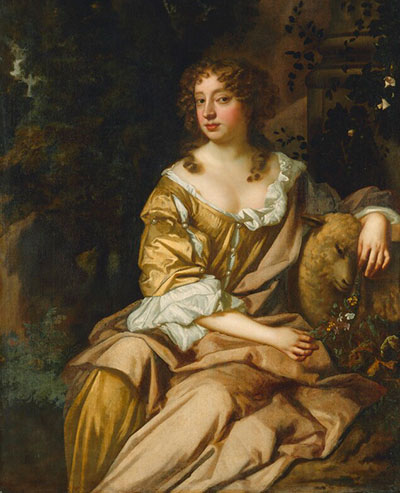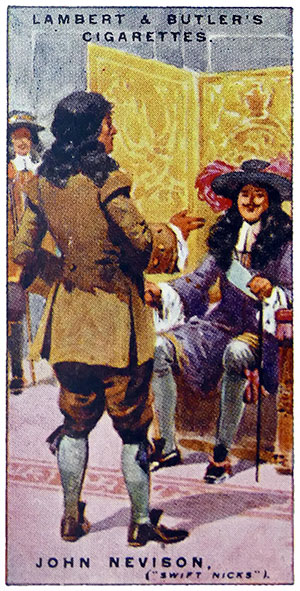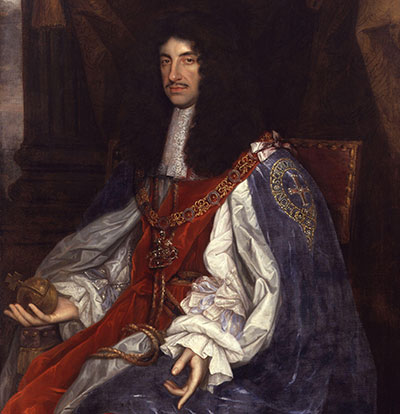Swift Nix (Nicks)—an English highwayman and his Irish career
Published in Features, Issue 5 (September/October 2021), Volume 29By Amy L. Harris

Above: Nell Gwynn, one of the many mistresses of Charles II, who may have petitioned the king on Swift Nix’s behalf. Her sister, Rose, was married to his associate, highwayman John Castles (Cassells). (NPG, UK)
Thomas Dingley (Dineley), an English antiquarian, visited Ireland in 1680–1. In his journal he recorded Swift Nicks (Nix) as one of eight army captains whom he met in Limerick. A literature search finds ‘Swift Nicks/Nix’ classed as a nickname associated with the English highwayman John Nevison, who lived in the latter part of the seventeenth century, and also with Dick Turpin, an eighteenth-century highwayman. The name has only been associated with Nevison since the nineteenth century. Earlier stories about highwaymen by Alexander Smith (1714) and William Defoe (1724) refer to a Swift Nicks (Nix) in conjunction with a famous ride from London to York. Despite their accounts, modern writers still see ‘Swift Nicks’ as a pseudonym.
There is no doubt that what Dingley records is credible. The question is who was Swift Nix, what was he doing in Ireland and is he the same highwayman mentioned in the famous horse ride?
The real Swift Nix
Swift Nix was baptised at Bowdon, Cheshire, on 28 November 1638. His parents were Roger Nix and Anna Swift, hence his name, although his family history suggests that he could have been named after a famous relative, one Sir Robert Swift (d. 1625), who was considered to have been a great swordsman and was referred to as ‘Cavaliero Swift’ by Elizabeth I. Nothing is known about Nix’s formative years except that in 1664 he married Deborah Gosse in the parish of St Clement Eastcheap and St Martin Orgar in London.
In his account of the highwayman Captain Richard (Dick) Dudley, Smith mentions that Dudley committed some notorious robberies on the road with a Swift Nix. Official records also link Nix with another highwayman named Humble Ashenhurst. Dudley was a former soldier and there is evidence to suggest that Ashenhurst and Nix also had military connections. It may seem strange that soldiers would become highwaymen, but it was a career to which they resorted in order to supplement their incomes when their regiments were disbanded in peacetime. Moreover, they were well qualified for such a career, with expertise in horses and firearms.
Between 1668 and 1669 Swift Nix’s name appears in proclamations for the capture of a number of highwaymen for heinous robberies, murders and burglaries. His name appears alongside those of Humble Ashenhurst and John Cassells (Castles). Nix is recorded with the alias ‘Clark’, and this may have given rise to the assumption that the name Swift Nix was a pseudonym.
In 1670 Swift Nix’s name appears twice in the domestic State Papers against two pardons, the first on 14 June, ‘Warrant for the grant to Swift Nix of pardon, in the same form as granted 25 November 1667’, and the second on 15 October, ‘Grant to Swift Nix of pardon for all crimes mentioned in a former pardon, committed by him before 25 Nov. 1669’. How did Swift Nix obtain these pardons, particularly given the crimes that he is alleged to have committed?
The tale of the legendary horse ride

Above: A Lambert & Butler cigarette card depicting English highwayman John Nevison’s apocryphal audience with King Charles II (seated), who allegedly bestowed on him the nickname ‘Swift Nicks’. In fact, that nickname has only been associated with Nevison since the nineteenth century. (Alamy)
The name Swift Nix, according to a folktale, is linked to a famous horse ride to York from Gadshill on the London–Rochester road or, some say, from Barnet in Hertfordshire. According to the story, Nix was recognised in the course of a highway robbery early one morning. In an attempt to establish an alibi, he immediately set out on a fast ride to York. On arrival there later that day, he ensured that he was noticed by speaking to the mayor at a bowling green. At the subsequent trial his defence argued, with evidence from the mayor, that he could not have been in two places so remote on the same day, and Nix was acquitted.
When Nix subsequently boasted about his feat it came to the attention of King Charles II, who granted him an audience. The king promised him a pardon if he confessed the truth to him privately, which Nix duly did. Charles pardoned him and conferred on him the name ‘Swift Nicks’. While it may be a folk-tale, there is an element of truth in it. As already mentioned, it is recorded in official sources that Nix was granted not just one but two pardons.
It is suggested here that, rather than by a dubious revelation to Charles II, Nix was likely assisted to obtain his pardons by his fellow highwayman John Castles (Cassells). Castles was married to Rose Gwynn, sister of Eleanor (Nell) Gwynn, one of the many mistresses of Charles II. In 1670 Nell Gwynn was pregnant with her second child by Charles. Swift Nix would have needed someone close to the king to petition on his behalf for a pardon. It is likely that he approached Castles (who had already obtained a pardon) to ask his wife, Rose, to intercede on his behalf.
Captain Swift Nix moves to Ireland
We next hear of Nix, now pardoned, in 1674 as having purchased a commission from soldier and poet William Wycherley (1641–1716). It is worth speculating whether this was facilitated by Charles II, as Nix’s notoriety in England may have started to become an issue. Nix’s regiment was sent to Ireland, as it is mentioned in a letter of 1674 from William Harbord (in England) to Lord Essex (in Ireland), which also describes a brawl between his company of foot and that of another on the march from Winchester to Chester. Harbord refers to Nix as ‘the famous robber who has bought Mr Wycherley’s company in the Duke of Buckingham’s regiment’.
In 1676, sometime after Nix’s arrival in Ireland, a letter was sent from Secretary Coventry to Lord Ranelagh, suggesting that Nix had returned to his old ways to supplement his often late or non-existent army pay. Nix is also recorded as an interested party in the will of Sir Alexander Bence, who was active in the Royal African Company. Little more is known about Swift Nix and his subsequent career in Ireland, but he is cited in a number of Irish sources. As well as Thomas Dingley’s account, the army lists record that Nix’s regiment was in Newry in December 1678, in Limerick in 1680 and in June 1682, and was part of Lord Mountjoy’s regiment in 1685.

Above: King Charles II—according to the State Papers, he granted two pardons to Swift Nix in 1670. (NPG, UK)
In July 1687 the Verney family papers record: ‘’Tis said that Capt. Swiftnix who in Ireland would not deliver his commission to the Lord-General, is in that Kingdome by 15 or 16 men cut to pieces; he was formerly a highwayman in England’. This account may refer to when the new Catholic lord deputy of Ireland, the Earl of Tyrconnell, in 1687 replaced Protestant officers and soldiers with Catholics. Nix as a Protestant would have been a victim of this policy, resulting in loss of his investment and employment, but there is some doubt that he was murdered, as it would have been reported in official records. The calendar of State Papers Domestic for James II (1687) recorded: ‘to James Wogan to be captain of the company whereof Capt. Swift Nix was captain’.
In 1699 the English bookseller John Dunton, on a visit to Kildare, recorded in his journal:
‘… at one which (that was shewn to me) called Greenhills sometime since dwelt the famous Nix, called Swift Nix in England from the robberie committed neare York in the afternoon and came to London, that evening on the same horse. He had a foot company in this kingdome, and was a man of good substance, but lost all by this last war. So that what he got over [blank] back, was lost under his belly.’
Dunton’s reference to the famous horse ride is further evidence of its association with Nix.
The Prerogative Court in Ireland for 10 April 1688 records Swift Nix’s will, which names his three children, Henry, Robert and Francis. In the same year the register of St David’s Church in Naas, Co. Kildare, records the burial of Captain Nicks, nicknamed ‘Swift Nicks’, in its churchyard. Even in death his name was still considered to be a nickname. The Inchiquin papers mention that his groom and two best mares were to be acquired by a member of the O’Brien family.
The famous horse ride revisited
The story of the famous horse ride associated with Swift Nix is, like many myths, loosely based on actual events and can be interpreted on two levels. The first is that it is likely that the story was manufactured to obfuscate the reality of how Nix achieved his pardons. Nix was apparently known as ‘the famous robber’ in court circles, which suggests that the reason for his pardons was widely known. Secondly, the story can also be seen as a criticism of Charles II’s pandering to highwaymen, particularly in the cases of Nix and Cassells, who were involved in criminal acts for which the punishment was hanging.
Today, while the tale of the legendary horse ride lives on, attributed mostly to other highwaymen, the real Swift Nix is long forgotten in lore. More importantly, the reality of how he received his pardons is cleverly obscured by the tale. Smith in his conclusion about Swift Nix says that after his move to Ireland he ‘afterwards lived very honest’, which is more than can be said for his former comrades, who both met tragic ends.
Amy L. Harris is a graduate of University College Dublin and Sussex University.
FURTHER READING
W. Defoe, A tour through England and Wales, vol. I (London, 1724).
J. Dunton (ed. A. Carpenter), Teague Land or a merry ramble to the Wild Irish (1698) (Dublin, 2000).
A. Smith (ed. A.L. Hayword), A complete history of the lives and robberies of the most notorious highwaymen, footpads, shoplifts, & cheats of both sexes (London, 1926).
















